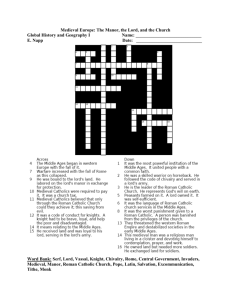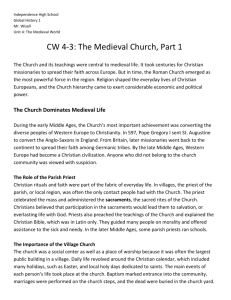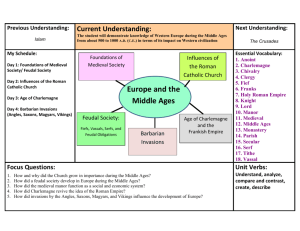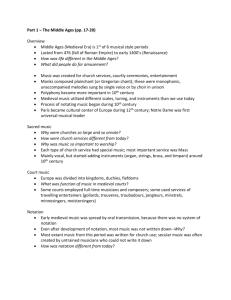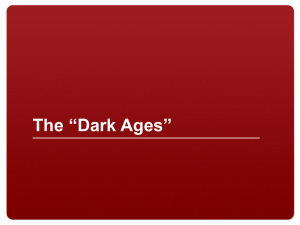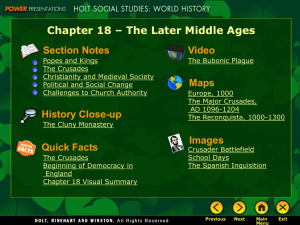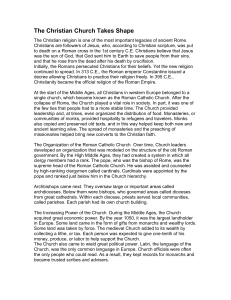Ch. 3
advertisement
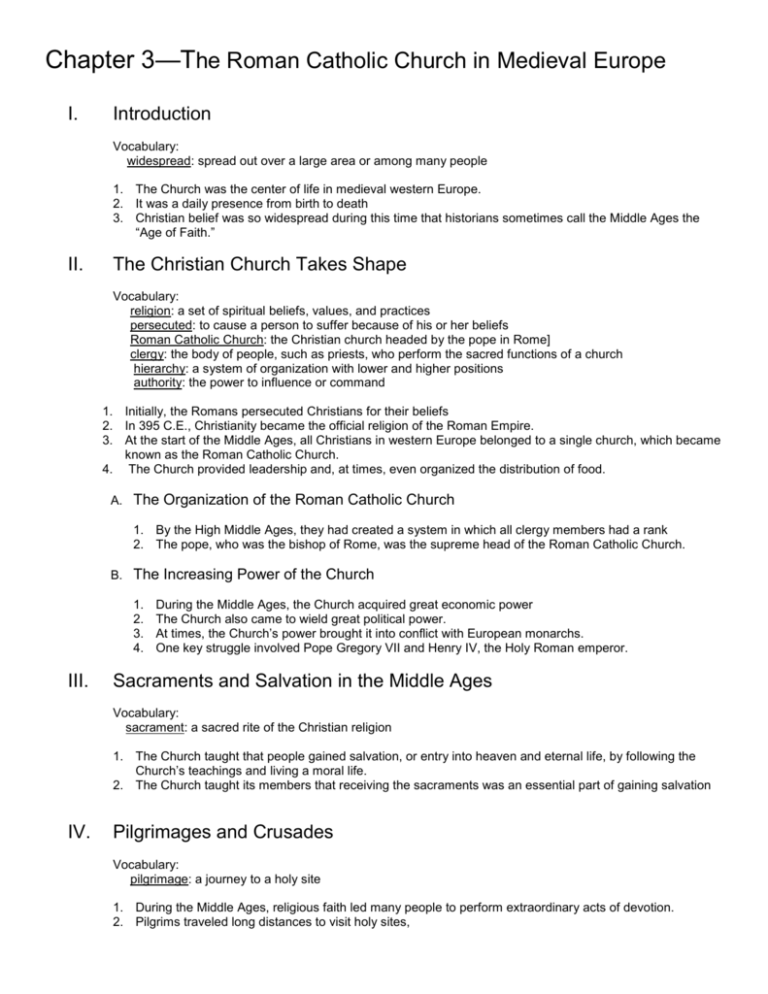
Chapter 3—The Roman Catholic Church in Medieval Europe I. Introduction Vocabulary: widespread: spread out over a large area or among many people 1. The Church was the center of life in medieval western Europe. 2. It was a daily presence from birth to death 3. Christian belief was so widespread during this time that historians sometimes call the Middle Ages the “Age of Faith.” II. The Christian Church Takes Shape Vocabulary: religion: a set of spiritual beliefs, values, and practices persecuted: to cause a person to suffer because of his or her beliefs Roman Catholic Church: the Christian church headed by the pope in Rome] clergy: the body of people, such as priests, who perform the sacred functions of a church hierarchy: a system of organization with lower and higher positions authority: the power to influence or command 1. Initially, the Romans persecuted Christians for their beliefs 2. In 395 C.E., Christianity became the official religion of the Roman Empire. 3. At the start of the Middle Ages, all Christians in western Europe belonged to a single church, which became known as the Roman Catholic Church. 4. The Church provided leadership and, at times, even organized the distribution of food. A. The Organization of the Roman Catholic Church 1. By the High Middle Ages, they had created a system in which all clergy members had a rank 2. The pope, who was the bishop of Rome, was the supreme head of the Roman Catholic Church. B. The Increasing Power of the Church 1. 2. 3. 4. III. During the Middle Ages, the Church acquired great economic power The Church also came to wield great political power. At times, the Church’s power brought it into conflict with European monarchs. One key struggle involved Pope Gregory VII and Henry IV, the Holy Roman emperor. Sacraments and Salvation in the Middle Ages Vocabulary: sacrament: a sacred rite of the Christian religion 1. The Church taught that people gained salvation, or entry into heaven and eternal life, by following the Church’s teachings and living a moral life. 2. The Church taught its members that receiving the sacraments was an essential part of gaining salvation IV. Pilgrimages and Crusades Vocabulary: pilgrimage: a journey to a holy site 1. During the Middle Ages, religious faith led many people to perform extraordinary acts of devotion. 2. Pilgrims traveled long distances to visit holy sites, 3. Pilgrims went on these journeys to show their devotion to God, as an act of penance for their sins, or in hopes of being cured of an illness. 4. A second type of extraordinary service involved fighting in the Crusades. 5. The Crusades were a series of military expeditions to the land where Jesus had lived, which Christians called the Holy Land. V. Art and Architecture Vocabulary: technique: a specialized method used to achieve a desired result 1. During the Middle Ages, most art was made for a religious purpose. 2. Medieval art and architecture found their most glorious expression in cathedrals, the large churches headed by bishops 3. Gothic cathedrals were designed to look like they are rising to heaven. 4. Cathedrals were visible expressions of Christian devotion. VI. Education Vocabulary: natural law: the concept that there is a universal order built into nature that can guide moral thinking 1. 2. 3. 4. During the Middle Ages, most schooling took place in monasteries, convents, and cathedrals. In medieval times, the clergy were the people most likely to be educated Starting in the 1200s, cathedral schools gave rise to universities. Thomas Aquinas (uh-KWINE-iss), an Italian scholar of philosophy and theology, tried to bridge the gap between reason and faith. 5. Aquinas wrote logical arguments in support of his faith to show how reason and religious belief worked together. VII. Holidays 1. 2. 3. 4. 5. 6. Medieval Europeans enjoyed many festivals and fairs that marked important days of the year. Most of these celebrations were connected in some way to the Church Two of the main medieval holidays were Christmas and Easter. Christmas is the day when Christians celebrate the birth of Jesus. Easter is the day when Christians celebrate the Resurrection In Christian belief, the Resurrection is Christ’s rising from the dead. VIII. Monks, Nuns, and Firars Vocabualry: religious order: a brotherhood or sisterhood of monks, nuns, or friars 1. Some men and women, however, solemnly promised to devote their lives to God and the Church. A. The Monastic Way of Life 1. 2. 3. 4. The man who developed the monastic way of life in western Europe was Saint Benedict. Monks spent their lives in prayer, study, and work. Other duties included caring for the poor and sick, teaching, and copying religious texts Both monks and nuns joined religious orders. Each order had its own distinctive rules and forms of service 5. Monastic life was one of the few opportunities open to medieval women who did not wish to marry. 6. Women who became nuns lived in convents. B. Friars 1. Some people wanted to live a religious life without the seclusion of the monastery 2. Instead of living in monasteries, Franciscan friars traveled among ordinary people to preach and to care for the poor and sick



